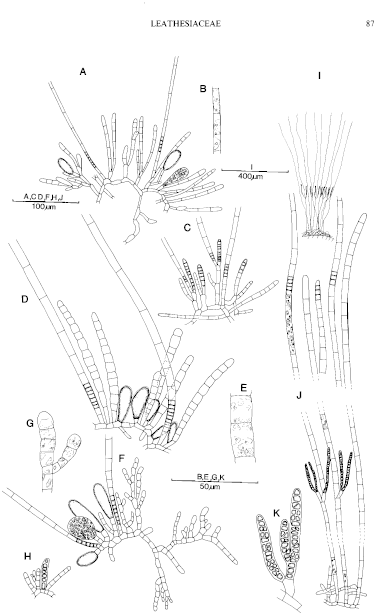|
|
|
|
|
|||||||||||
|
Electronic Flora of South Australia Species Fact Sheet
Phylum Phaeophyta – Order Chordariales – Family Leathesiaceae
Thallus (Fig. 24F) minute, forming a slight layer from the cortex of Helminthocladia australis, with basal endophytic filaments and branched, emergent, determinate cortical filaments and hairs. Basal filaments (Fig. 24F) branched, extending laterally in the host cortex, cells 5–8 µm in diameter and L/B 1–2. Medulla slight, of erect, often branched filaments continuing as emergent cortical filaments, and producing phaeophycean hairs. Determinate cortical filaments (Fig. 24F) somewhat irregular in height, usually of basally branched systems, often varying slightly in diameter upwards, (40–) 50–70 (–80) µm and 6–10 cells long, 6–8 µm in diameter with cells L/B 1–1.5; terminal cell rounded. Phaeoplasts (Fig. 24G) one to a few per cell, irregularly shaped, with or without a pyrenoid. Phaeophycean hairs frequent, 6–10 µm in diameter.
Reproduction: Unilocular sporangia (Fig. 24F) clavate to ovoid, often becoming subglobose when mature, (40–) 50–65 (–90) µm long and (30–) 35–50 (–70) µm in diameter, borne on short pedicels from basal or medullary filaments. Plurilocular sporangia (?) (Fig. 24H) about 40 µm and 6 cells long, 8–10 µm in diameter.
Type from Sou' West R. mouth, Kangaroo I., S. Aust., on Helminthocladia australis, lower eulittoral (Bailey, 8.i.1966); holotype in ADU, A49564.
Distribution: Only known from the type collection.
Taxonomic notes: Strepsithalia aemula is named from and distinguished by the short cortical filaments of similar length to the unilocular sporangia. It is probably most closely related to S. liebmanniae Miranda (Hamel 1935, p.151, fig. 34,111) which has short plurilocular sporangia borne on branched cortical filaments and a different host.
References:
HAMEL, G. (1935). Phéophycées de France. Fasc. II, pp. 81–176. (Paris.)
The Marine Benthic Flora of Southern Australia Part II complete list of references.
Publication:
Womersley, H.B.S. (14 December, 1987)
The Marine Benthic Flora of Southern Australia
Part II
©Board of the Botanic Gardens and State Herbarium, Government of South Australia
Illustration in Womersley Part II, 1997: FIG. 24 F–H.

Figure 24 enlarge
Fig. 24. A–C. Strepsithalia liagorae (A,B, ADU, A49565; C, ADU, A54929). A. Thallus with determinate cortical filaments, phaeophycean hairs and unilocular sporangia arising from basal filaments. B. Cells of a determinate cortical filament, with phaeoplasts. C. Thallus with plurilocular sporangia, and phaeophycean hairs arising from erect or basal filaments. D,E. Strepsithalia leathesiae (ADU, A49777, holotype). D. Thallus with determinate cortical filaments, phaeophycean hairs and unilocular sporangia arising from basal filaments. E. Cells of a determinate cortical filament with phaeoplasts. F–H. Strepsithalia aemula (ADU, A49564, holotype). F. Thallus with branched determinate cortical filaments, phaeophycean hairs and unilocular sporangia arising from basal filaments. G. Cells of a determinate cortical filament, with phaeoplasts. H. Basal filament with a probable plurilocular sporangium. I–K. Acrotrichium amphibolis (ADU, A52820, holotype). I. Thallus (diagrammatic) on Amphibolis, showing basal filaments, medullary filaments, stratum of plurilocular sporangia, and determinate cortical filaments with some continuing as phaeophycean hairs. J. Ditto showing cell detail with central parts of cortical filaments omitted. K. Detail of plurilocular sporangia.

|
Email Contact: State Herbarium of South Australia |

|